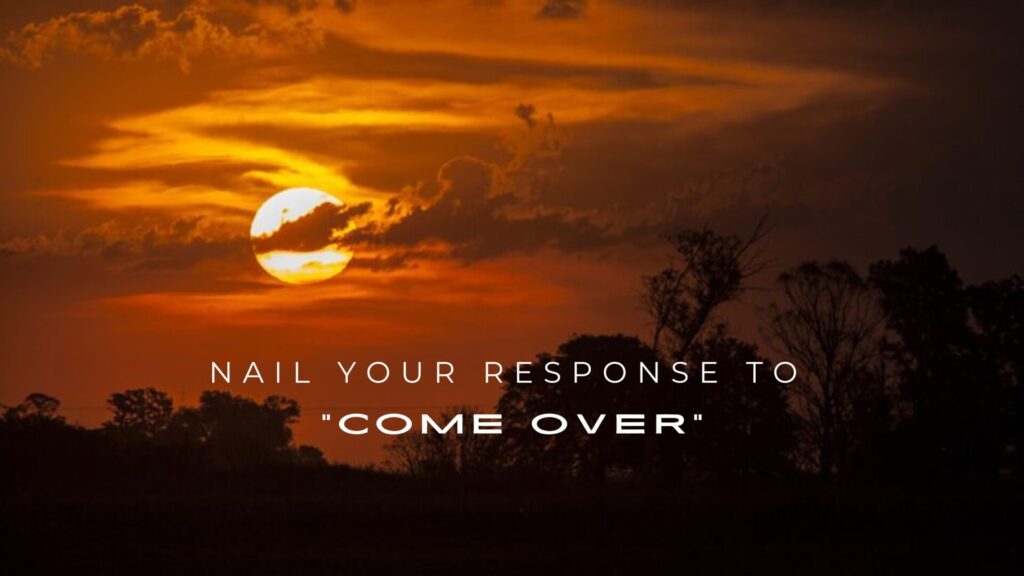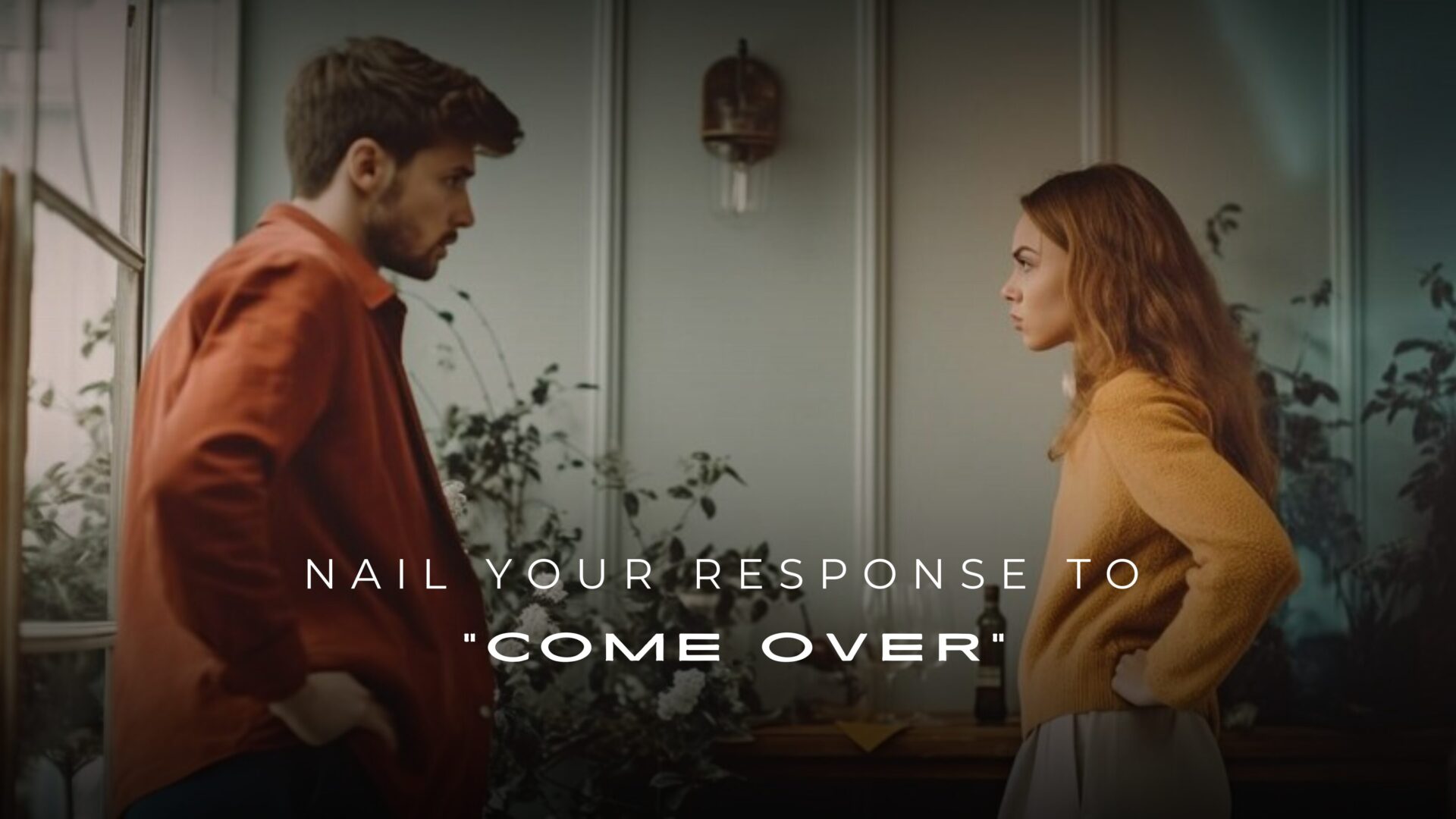Have you ever felt the itch to invite someone over but didn’t know how to phrase it? You’re not alone. The “come over” text is a powerful tool in our digital communication arsenal, bridging gaps and strengthening relationships. But like any tool, its effectiveness hinges on how well you use it. In this guide, we’ll dive into the nuances of the “come over” text, exploring everything from timing and crafting the perfect message to interpreting responses and handling rejection.
The Psychology Behind a “Come Over” Text
In our fast-paced, tech-savvy world, how we communicate has evolved dramatically. While seemingly simple, the “come over” text carries a wealth of psychological undertones. It represents a blend of vulnerability and invitation, often leading to hesitation in sending and receiving.
When you send a “come over” text, you’re putting yourself out there, opening up the possibility of rejection or acceptance. This duality can make sending such a message a nerve-wracking experience. Understanding this can help you approach the situation with empathy for yourself and the recipient.
When to Send a “Come Over” Text
Timing is everything. Whether you’re inviting a friend, a romantic interest, or a family member, the stage of your relationship plays a crucial role. Too early, and you might come off as too forward; too late, and you might miss your window of opportunity.
For romantic interests, it’s best to wait until you’ve established a comfortable rapport. The timing can be more flexible for friends but consider their current commitments. Family members usually appreciate a heads-up, especially when juggling multiple responsibilities.

200+ Responses to “Come Over” Text
Acceptance
- Absolutely! Be there in 10 minutes.
- On my way right now!
- Sure thing! I’ll head over in a bit.
- Yes! I’ll be there soon.
- Count me in! See you in a few.
- I’m already getting ready. See you soon!
- I’d love to! Be there shortly.
- Awesome! I’ll be there as soon as I can.
- Totally! I’ll be over in a little while.
- I can’t wait to hang out! Leaving now.
Conditional Acceptance
- Sure, what time works for you?
- I can come over, but I might be late. Is that okay?
- Sounds good! Can I bring a friend?
- I’d love to! I just need to finish a few things first. Can you wait a bit?
- I can come over, but I need to be back by 8. Is that alright?
- I’d love to! Are we still planning to order food?
- Sure, but I need to know if there’s parking nearby.
- Okay! Can I bring my dog?
- I want to come over. Who else is going to be there?
- I can swing by, but only for an hour. Is that cool?
Tentative Responses
- Maybe. I’ll let you know in a bit.
- I can come. Let me check my plans.
- I am still waiting. I’ll get back to you soon.
- I’d love to, but I need to see if I can rearrange some things.
- I’ll try, but I can’t promise anything right now.
- Possibly. I’ll have to see how my day goes.
- I can swing by later. I’ll keep you posted.
- I’d like to, but let me double-check my schedule first.
- I’ll confirm with you soon.
- I want to come, but must figure out a few things first.
Rejection
- Sorry, I can’t make it today.
- I have other plans tonight, so I won’t be able to come over.
- I wish I could, but I need to catch up with work.
- Unfortunately, I’m not available at this time.
- I have a prior commitment, so I can’t come over.
- I’m not able to make it, but let’s catch up another time.
- Sorry, I can’t come over. I hope you understand.
- I’m going to have to pass this time. Maybe next week?
- I’m not free today. Let’s try again soon.
- I’m busy today, so I won’t be able to make it. Sorry!
Excuses or Deferrals
- I’d love to, but I have a lot of work to finish first. Can we do it later?
- I’m not feeling well today. Can we reschedule?
- I’ve got a family thing I need to take care of. How about another time?
- I’m swamped with errands right now. Maybe later?
- I have a deadline coming up, so I need to stay in. Let’s plan for another day.
- I’m not up for going out today. How about next weekend instead?
- I’ve got a prior engagement, but can we meet later this week?
- I’m not able to make it right now, but I’d love to catch up another time.
- I’m tied up with something urgent. Can we look at a different day?
- I have a busy day ahead. Let’s try for another time.
Clarification or Inquiry
- What’s the plan for when I get there?
- Can you tell me more about what you had in mind?
- Who else will be there?
- What time are you thinking of?
- Is there anything specific you need me to bring?
- What’s the occasion for this?
- Do you have any particular plans for tonight?
- Are you looking for something in particular when I come over?
- Can you give me more details about what we’ll be doing?
- Is there anything I should prepare or bring with me?
Flirty or Playful Responses
- Only if you promise to make me dinner!
- I’ll come over, but only if you have Netflix ready for us!
- I’ll come only if you’re ready for a fun night!
- I might come over if you give me a good reason to 😉
- I can’t wait to see you! Hope you’re ready for some fun!
- I’d love to, but you owe me a drink first!
- If you can handle my company, I’m on my way!
- I guess I could come over if you promise to make it worth my while 😉
- Only if you’re ready for a surprise!
- Sure, but only if you’ve got some sweet treats waiting!
Noncommittal Responses
- I’ll see how things go.
- Depending on how my day turns out.
- I’m not sure yet. I’ll keep you posted.
- I’ll have to think about it and get back to you.
- Possibly. I’ll let you know later.
- I am still trying to figure it out. I’ll check and see.
- I might, but I can’t confirm just yet.
- Could be. I’ll decide a bit later.
- I’ll have to see how things shape up today.
- I’m unsure right now. I’ll get back to you soon.
Context-Specific Responses
- Is this about the game night we planned?
- Are we hanging out for the birthday party?
- Is this because you need help with the project?
- Are we still on for the movie marathon?
- I thought we were meeting up for coffee. Are we changing plans?
- Is this a casual hangout or something more specific?
- Is this related to the plans we talked about last week?
- I wasn’t expecting this. Is everything okay?
- Is this for the event we discussed earlier?
- Are you asking because of the issue we talked about earlier?
Practical Concerns
- Do you have parking available?
- What’s the best way to get there? I’m not familiar with the area.
- Can I bring anything with me, like snacks or drinks?
- Can I come later? I have a few things to wrap up first.
- What’s the best time for me to arrive?
- Do you have a specific dress code or anything I should know about?
- Will there be a place to work if I need to finish something?
- Do you have any pets? I’m allergic and need to be prepared.
- Is there anything I should avoid bringing or doing while I’m there?
- Can you confirm your address again? I just want to make sure I don’t get lost.
Expressing Enthusiasm or Excitement
- Yes! I’ve been looking forward to hanging out all week!
- Awesome! I can’t wait to see you!
- This sounds fantastic! I’ll be there as soon as I can!
- I’m so excited! I can’t wait to catch up!
- Absolutely! I’m thrilled you asked!
- Yes! I’ve been hoping for an invite like this!
- I am so pumped! I’m looking forward to it!
- I’m excited! See you soon!
- I’m so ready for this! I’ll be there in no time!
- Yes! This is going to be great; I can’t wait!
Expressing Reluctance
- I’m not sure I’m up for it, but I’ll try to make it.
- I’m feeling a bit hesitant, but I might come over.
- I could come, but I’m not in the mood.
- I’m not feeling it today, but I’ll see if I can.
- I’m reluctant, but I don’t want to disappoint you. I’ll try to come.
- I’m unsure, but I’ll see if I can swing by.
- I’m feeling slightly off, so I’m unsure if I’ll make it.
- I’m not super excited about it, but I might come if possible.
- I’m hesitant, so I’ll have to think about it.
- I’m not in the mood, but I’ll see if I can make it work.
Offering Alternatives
- How about we meet up at a café instead? I’m not up for staying in.
- Would you be interested in grabbing lunch tomorrow instead?
- Could we do this another day? I have something planned for tonight.
- What do you think about a video call instead? I can’t make it over today.
- Can we meet halfway or do something outdoors instead? I’m not up for being indoors.
- Let’s plan for next weekend. I’m tied up this week.
- Would you be okay with meeting for breakfast instead?
- I’m not able to come over, but let’s plan a day out together soon.
- Can we do a virtual hangout tonight? I’m not feeling up to going out.
- I’d prefer to meet up later in the week. How does that sound?
Expressing Uncertainty
- I’m not quite sure yet. I’ll let you know later.
- I’m on the fence about it. Can I get back to you soon?
- I’m unsure at the moment. I’ll have to see how things go.
- I’m kind of uncertain about my plans. I’ll keep you posted.
- I can’t make it yet. I’ll check and get back to you.
- I’m a bit unsure right now. I’ll need to think it over.
- I’m not entirely sure. Can I let you know in a bit?
- I might be able to come, but I’m not certain yet.
- I’m undecided at the moment. I’ll see how my day unfolds.
- I’m not sure if I can make it. Let me figure things out and get back to you.
Confirming Logistics
- What time should I come over?
- Can you confirm your address again? I want to make sure I have it right.
- Do you want me to bring anything with me?
- Is there a specific time you’d like me to arrive?
- What’s the best way to get into your building?
- Do you need me to call when I arrive, or is there a doorbell I should use?
- Should I expect to stay long, or is it a quick visit?
- Can you give me directions or landmarks to look for?
- Do you have any special instructions for getting there?
- Is there a particular entrance I should use?
Apologetic Responses
- I’m sorry, but I won’t be able to make it today.
- I wish I could come over, but something urgent came up. Sorry!
- I’m so sorry, but I have to cancel. Can we try another day?
- I feel bad about this, but I can’t make it. I hope you understand.
- I apologize for the late notice, but I have a prior commitment.
- I’m sorry, but I’m not feeling well. Let’s reschedule!
- Apologies, but I won’t be able to make it. Can we meet another time?
- I’m sorry, but something came up, and I have to stay in.
- I apologize for the inconvenience, but I can’t come over today.
- I’m sorry about this, but I’ve got something else planned.
Suggesting a Change of Plans
- Let’s meet at a different time. I’m a bit busy now.
- Let’s plan for another day. I’m swamped with work today.
- What if we do this next weekend instead? I’m not free today.
- How about a lunch date instead? I can’t make it over tonight.
- Can we switch to a virtual hangout for today and meet in person later?
- I’m tied up now. Can we reschedule for tomorrow?
- Would it work if we met up for brunch instead of dinner?
- Can we push this to later in the week? I’m a bit overwhelmed right now.
- Let’s do a different activity if you’re up for it. I’m not feeling up to this.
- Can we meet up at a café instead? I’m not up for hosting today.
Checking for Compatibility
- What’s the plan for today? I want to make sure it’s something I’ll enjoy.
- What’s on the agenda? I just want to make sure it aligns with my interests.
- Are we doing something specific, or is it just a hangout? I want to be prepared.
- What do you have in mind?
- I’m curious about what we’ll be doing. Can you fill me in?
- Will there be activities I’m comfortable with? Just checking before I commit.
- What’s the vibe for today? I want to make sure it’s something I’ll be into.
- Are there specific plans for tonight? I’d like to know what to expect.
- I want to make sure we’re on the same page. Can you give me more details?
- Can you let me know what’s planned? I want to make sure it suits me.
Showing Concern
- Is everything okay? Your message sounded urgent.
- Do you want me to come over? You seemed a bit stressed.
- I’m a bit concerned—are you alright? Do you need anything specific?
- Is something wrong? You don’t usually ask me over so suddenly.
- I’m worried about you. Is there something I should know before I come over?
- Are you feeling okay? You might need some support.
- Is everything alright? I just want to make sure I’m not intruding.
- I hope everything’s fine. Let me know if you need help with something.
- I’m here if you need me. Are you sure it’s a good time for a visit?
- I’m a bit concerned. Is there something specific you need help with?
Expressing Surprise
- Wow, that’s unexpected! What’s up?
- I didn’t see this coming. What’s the occasion?
- Oh, really? This is a surprise. What’s going on?
- This is sudden. Is everything okay?
- I wasn’t expecting this! What’s the plan?
- Wow, I didn’t know you wanted me over. What’s the reason for the invite?
- This is a surprise! Did something happen?
- I didn’t think you’d be asking me to come over. What’s up?
- This is unexpected! Is there a special reason for the invite?
- Oh, this is a surprise! Are we celebrating something or just hanging out?
Crafting the Perfect “Come Over” Text
Creating an inviting, casual message is key. Here are some tips:
- Keep It Simple: Keep your text simple. A straightforward, “Hey, want to come over?” often works best.
- Add a Personal Touch: Tailor your message to the recipient. Mentioning a shared interest or recent conversation can make your invitation more appealing.
- Be Clear and Direct: Ensure your message conveys your intention. Ambiguity can lead to confusion and awkwardness.
Examples of Effective “Come Over” Texts
For Friends: “Hey, do you have some free time today? Come over, and let’s catch up!”
For Romantic Interests: “Hey, I just got a new movie I think you’ll love. Want to come over and watch it with me?”
For Family Members: “Hi! I haven’t seen you in a while. How about coming over for dinner this weekend?”
Common Mistakes to Avoid
- Being Too Vague: Messages like “Come over?” without context can confuse the recipient.
- Overcomplicating the Message: Long-winded texts can dilute the impact. Keep it brief and to the point.
Reading Between the Lines: Interpreting Responses
Understanding the nuances of replies is crucial:
- Positive Responses: Look for enthusiasm and eagerness. Responses like “Sure, what time?” or “I’d love to!” indicate interest.
- Negative Responses: Polite declines or non-committal replies like “I’m not sure, maybe another time” suggest hesitation or disinterest.
Handling Rejection Gracefully
Rejection can sting, but handling it with grace is important:
- Responding to a Decline: A simple “No worries, maybe another time!” maintains respect and leaves the door open for future invitations.
- Maintaining Boundaries: Respect their decision without pressing further. This shows maturity and respect for their comfort.
Follow-Up Texts: Keeping the Conversation Going
Not every invitation will lead to an immediate yes, but follow-up texts can keep the conversation alive:
- Suggested Follow-Up Messages: “No problem! What are you up to this weekend?” or “Maybe we can plan something for next week?”
- Transitioning to Other Topics: If the invitation is declined, smoothly shift the conversation to another topic to avoid awkwardness.
Using Emojis and GIFs Effectively
Visual elements can enhance your message:
- Enhancing Your Message: Emojis can convey warmth and friendliness. A smiley face 😊 or thumbs up 👍 can soften the tone.
- Appropriate Use Cases: Use emojis and gifs to add a playful element, but don’t overdo it. Keep it appropriate to the context and your relationship.
When a “Come Over” Text Turns into a Date
If your invitation is accepted, especially by a romantic interest, it’s time to prepare:
- Preparing for Their Arrival: Ensure your place is tidy and welcoming. A clean environment sets a positive tone.
- Setting the Mood: Consider lighting, music, and any planned activities. Creating a cozy atmosphere can make the visit more enjoyable.
Ensuring Comfort and Safety
Making your guest feel at ease is paramount:
- Creating a Welcoming Environment: Offer refreshments and make sure they feel comfortable. Small gestures can go a long way.
- Discussing Boundaries: If needed, have an open conversation about boundaries to ensure mutual comfort.
What to Do If They Don’t Show Up
No-shows can be disappointing, but handling them well is important:
- Handling No-Shows: Send a polite message like, “Hey, I noticed you couldn’t make it. Everything okay?”
- Maintaining Communication: If they apologize, accept it graciously and suggest rescheduling if appropriate.
Cultural Differences in “Come Over” Texts
Cultural norms can influence how such invitations are perceived:
- Understanding Diverse Perspectives: In some cultures, direct invitations may be seen as too forward, while in others, they are welcomed.
- Adapting Your Approach: Tailor your message to fit cultural expectations, showing respect and understanding.
Conclusion
In conclusion, mastering the art of responding to a “Come Over” text can significantly enhance your communication and relationship dynamics. With over 200 curated responses, you can handle these invitations with confidence and charm. Remember, the key is to align your response with your comfort level and the nature of your relationship.
If you’re looking to refine your approach to other social interactions, check out our guide on:
Answer “Where Are You From?” with Confidence: 200+ Answers
FAQs
Q. What if they don’t respond at all?
If you don’t get a response, don’t take it personally. People get busy. You can follow up once, but if there’s still no reply, give it time before trying again.
Q. How long should I wait before sending a follow-up text?
Give it at least a day before sending a follow-up. This shows patience and respect for their time.
Q. Is sending a “come over” text late at night okay?
Late-night texts can be tricky. Unless you have that kind of relationship, it’s better to send your invitation during reasonable hours to avoid misunderstandings.
Q. How do I make a “come over” text less awkward?
Keep it casual and light. Adding a reason for the visit, like watching a movie or catching up, can make it feel less forced.
Q. Can a “come over” text be too forward?
It can be, depending on the relationship and timing. Gauge your rapport and consider the context before sending your invitation.










